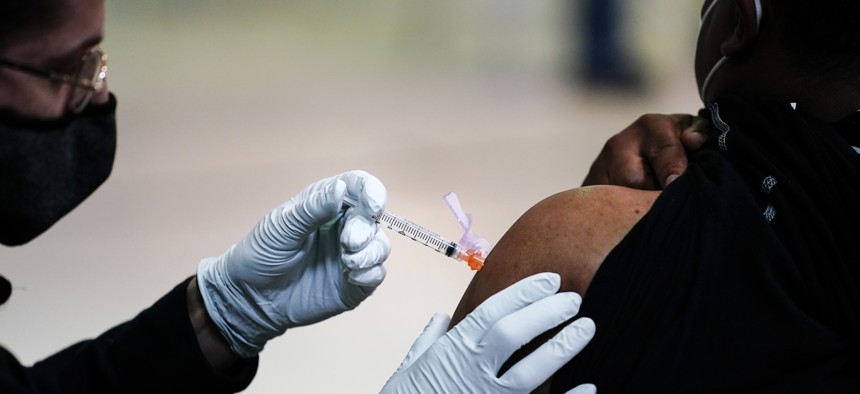How Public Health Officials Overcame Vaccine Barriers in Minority Communities

In this March 26, 2021, file photo, a member of the Philadelphia Fire Department administers the Johnson & Johnson COVID-19 vaccine to a person at a vaccination site at a Salvation Army location in Philadelphia. More Black Americans say they are open to taking the coronavirus vaccine amid campaigns to overcome a shared historical distrust of science and government. AP Photo/Matt Rourke
A series of reports issued by the Communivax Coalition explores resistance to Covid-19 vaccinations in four states and strategies to improve immunization rates.
Many local health departments launched campaigns to combat vaccine hesitancy to encourage residents to get immunized against Covid-19. But a new series of reports from local health experts in four regions of the country is pushing back on the notion that “vaccine hesitancy” is solely to blame for racial disparities in vaccination rates—instead highlighting the role that communications strategies and equitable distribution of resources have played.
The reports, from the CommuniVax Coalition, examine the barriers that communities of color in Alabama, Idaho, Maryland and California encountered during vaccine outreach campaigns and identify some of the solutions implemented.
In Prince George’s County, Maryland, a majority Black county in the suburbs of Washington, D.C., researchers found that many residents were eager to be vaccinated. But the allocation of fewer vaccines per capita to the county and operation of mass vaccination sites that were not accessible by public transit made it difficult for many to get vaccinated early on.
“Many participants reported that they had questions and concerns, and struggled to find digestible information for the lay public,” the report said. “For others, they were angered by state officials’ characterization of Black Prince George’s residents as vaccine hesitant when in fact, it was extremely difficult, if not impossible, for many to access this scarce resource.”
The strain of resources was compounded by the lack of restrictions on who could get vaccinated at large-scale sites in the county, said Dr. George Askew, the county’s deputy chief administrative officer for health, human services and education, during a panel discussion held last month on the report findings.
“What you had was folks who had greater resources, the ability to take off time from work, the ability to cross borders because they had cars, they were able to come and get vaccine that was being distributed in Prince George’s County but not captured by Prince Georgians,” Askew said. “That was part of the issue of equality versus equity.”
Discussions with the governor’s office about vaccine allotments and the formation of a county equity task force helped improve distribution. By collecting granular data about vaccinations by neighborhood and ZIP code, county health officers have been able to target outreach efforts to areas with low immunization rates, Askew said.
The disparate rate of coronavirus vaccination among races has been a cause for concern among U.S. public health officials since vaccines were made available. Particularly given that Black and Hispanic people have had higher rates of death and hospitalization from Covid-19 than white people.
In Southeastern Idaho, a largely rural area with an agriculture-focused economy and high Hispanic population, public health workers focused on outreach to farming communities and prioritized door-to-door outreach that enabled them the chance to dispel misconceptions about the vaccine. A common misconception among the population was that proof of legal residency in the United States was required in order to be vaccinated, said Maggie Mann, district director for Southeastern Idaho Public Health.
By advising people one on one that legal residency was not a requirement, health officials “removed a barrier to access that had been pretty significant for a sizable population in our counties,” Mann said.
Andrea Noble is a staff correspondent with Route Fifty.
NEXT STORY: Why Mail-in Voting Became a Partisan Issue





